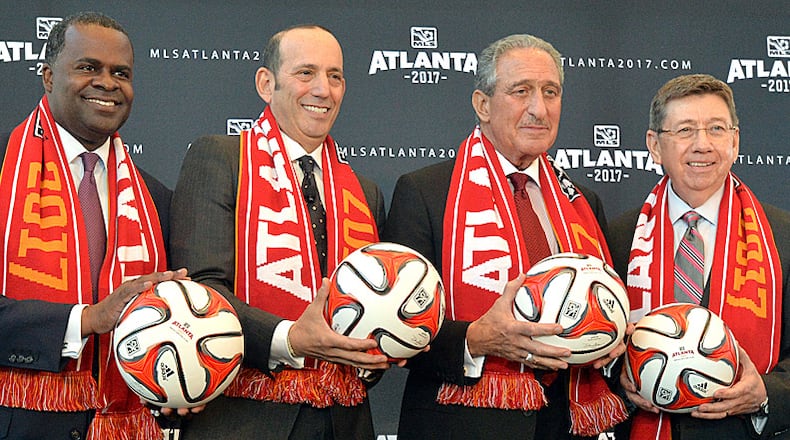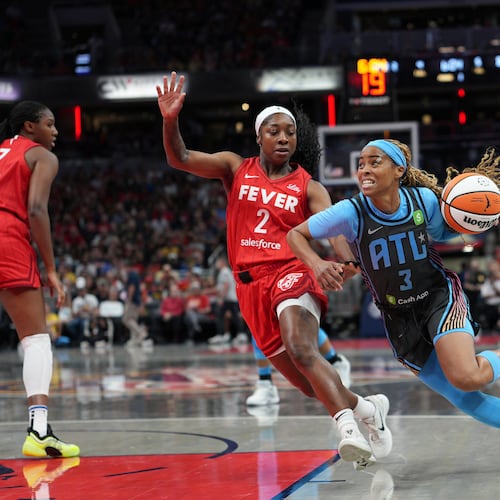Atlanta has its MLS team, which will open for business in 2017.
The franchise, owned by Arthur Blank, has already begun the search for a president, who will oversee all aspects of the operation, including identifying a coach.
But what about the players? When will the team start to have the faces and jersey numbers that attract the fans and move the merchandise?
When will Atlanta get its David Beckham or Clint Dempsey?
“(Scouting) is not a straight-forward process,” said Lino DiCuollo, MLS vice president for player relations and competition. “A lot of due diligence has to be done.”
Teams in MLS have numerous pools from which to draw players: the MLS academy, the MLS draft, free agents and designated players such as Beckham, to name a few.
Atlanta’s player acquisitions will likely start with the expansion draft in December 2016. During the last expansion draft, each MLS club had the opportunity to protect 11 players. Generation Adidas players (a joint venture between MLS and Adidas to target promising younger players) and Academy players did not count against a team’s 11 protected roster spots. MLS clubs could lose no more than one player.
That will be followed by the SuperDraft in January 2017, a four-round selection process from a pool mostly composed of college seniors, Generation Adidas players and some non-collegiate international players.
The team at any point could sign as many as three designated players, which are bigger-name players like Beckham whose salary is typically much higher than the others players, only a portion of which counts against each team’s salary cap ($3.1 million this year).
And then there are free agents, which is how players could arrive in Atlanta. Scouting can be a long, sometimes expensive and frequently complicated process that will begin long before the first game is played.
“It’s not like you can pick up a player from any part of the world and plug him in and he’s going to produce the same,” Toronto general manager Tim Bezbatchenko said.
Bigger teams in Europe can have a budget of as much as $5 million fueling as many as 30 scouts stationed in talent-rich hot spots around the globe.
MLS and its team take a different approach.
A typical MLS team has a scouting/technical director with one to five scouts. They are supplemented by a centralized scouting network run by the MLS that is unique to other leagues in the world. The office uses technology and collaboration to reduce costs to $1 million with a goal of not sacrificing quality.
DiCuollo oversees the scouting network, which consists of six consultants based in Central and South America. They recommend players to MLS, which has compiled approximately 300 reports on players. Those files are constantly being updated, with new players being added and others either edited or eliminated.
“If you have a short budget, you can scout around the world,” Bezbatchenko said. “It’s never a substitute for going to watch games.”
After a team identifies its need, they can access these reports, which can include personal information about the player such as salary demands, cities he would be interested in living and game videos.
“We try not from our building to make a judgment about a player’s quality,” DiCuollo said. “We are here to facilitate. If one of the consultants feels it would be a good fit, we will put in that info. Clubs have to do their own due diligence at that point.”
Then the hard works begins.
As Bezbatchenko said, the key is scouting the player in person, which can sometimes mean several trips made by everyone from the technical director to the coaches.
Bezbatchenko said it can take anywhere from a month to a year to evaluate a player. Once contact is made, negotiations could last another month.
And then there’s the human element, particularly with international players. Everything on paper can look like a perfect fit, but they are people with families, preferences and other factors that can cause the player to not produce as hoped.
“Once you bring them in, they are part of your family and you have to take care of them that way,” Bezbatchenko said. “Assimilation process is never easy for the club or the player.”
This process is typically much quicker (as soon as three weeks in some cases) when signing Designated Players because the scouting process can be done much quicker.
However, most of the roster will be built through the draft. Players who are drafted but aren’t ready for MLS can be loaned to an affiliate team in the USL Pro league or to a team in another league. While there, the player can get acclimated to professional soccer. When needed, the MLS team can recall the player.
MLS teams have exclusive league rights to players in their academies. These players don’t go through the SuperDraft. MLS clubs can have as many of these players as wanted.
The process can be a complicated, but is one that MLS Atlanta will soon be immersed in.
About the Author
Keep Reading
The Latest
Featured



